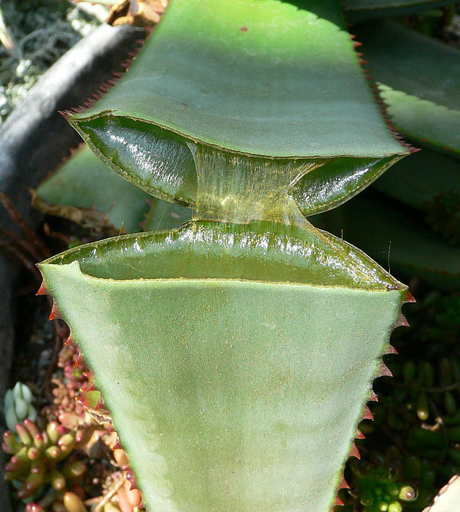Aloe vera ~ A story of Science and History
Did you know that Aloe vera’s global fame and current multi-billion dollar industry was just a case of being at the right place at the right time? …. In history, that is.

[Rather watch this story than read? Check our our YouTube video on our Tres Keikis Channel] [Or Listen to it 🔊 on our podcast Kiss My Grass]
After all, Aloe vera is just one species of over five hundred types of Aloe plants, so why does she get all the credit? Why didn’t the ancient global population cultivate more of her sisters? I know my kids would not stop complaining about “why does she get all the attention?, It’s not faaair!”
In order to appreciate how Aloe vera became a global phenomena, we need to take a look at her home town. Where did she first get her start? Just like most mysteries, one needs to start at the beginning and then follow the clues.
For many centuries, her origins were a mystery because she’s been all over the world for thousands of years! After-all, Her first recorded medicinal use was chiseled into Sumerian clay tablet over 4,000 years ago! In 1500 BCE she was written about in an Ancient Egyptian papyrus detailing over twelve medical uses. By the first century BCE, she was cultivated throughout most of Eurasia. She’s been all over the world for so long, that many people have no idea where she got her start.

Figuring out where she came from is key to figuring out how she got HERE…..here, meaning one of the most well known plant-power-skin-care-healers of all time, not to mention how she needed up creating her multi-billion dollar commercial industry.
This is where the wonder of science enters the story. In 2015, a coalition of international researchers set out to assemble the most comprehensive genetic sampling of the aloe genus. They wanted to answer two questions. First. Where was aloe Vera’s original DNA from? Second, does she owe her success to being superior to other aloe species? Remember, she does have over 500 first cousins.

After several years have past assembling all their data of DNA analysis from samples that were growing all over the world, they determined that the original Aloe Vera DNA started on the northern end of the Arabian peninsula. That was her home town more than FIVE THOUSAND years ago.

The answer to their second question was even more surprising. They also concluded that the Aloe vera species was NOT any more superior to the other aloe species. It wasn’t hardier, it wasn’t more potent, it was just kind of there, minding its own business growing in the harsh desert, just waiting to be discovered.
Sometimes, just like in modern life, a person, or a plant, owes their success to a bit of luck.
Aloe Veras original hometown in the northern Arabian peninsula happened to be located at the right place and in the right point in history.
During the time when her species in the Arabian peninsula began to gain local popularity, two other plant power super stars were already in high demand in Rome and elsewhere in the European continent. Frankincense and Myrrh. These two had already been discovered by peoples far and wide, who would pay such hefty price for their powers, others were willing to risk life and limb to satisfy the demand. Unfortunately, Frankincense and Myrrh could only be found growing in southern Arabia, Somalia, and Ethiopia. Ancient merchants brought these precious fragrant spices to Rome on camel caravans, by way of one of the most ancient highways, the famous Incense Route.

I bet you can guess where this incense route passed through? Right through Aloe Vera’s home town!
Aloe vera, like many of her aloe relatives was already a local hero. The people in her town knew about her super medicinal powers, and they were happy to sell their little home town star to these passers by.
To make her even more attractive to these ancient entrepreneurs, the aloe species can be easily be cultivated from an offshoot. This means the locals didn’t need to sell an entire plant, they could keep cutting off little off shoots from the main plant, just stick them in dirt, and they will grow. This means the owners of one plant could create hundreds of smaller, portable plants for traveling merchants to take along the route. What an ideal travel companion! And a nice little return on investment for the cultivators.

After making her way through the incense route, within a couple hundred years she was being wildly traded along the Silk Road, which went in-and-out of Asia. Fast forward a couple hundred more years, where she made her global presence known in the America’s by way of boat with the Conquistadors. It seemed nobody wanted to leave home without her, and for good reason. She has amazing plant powers.
Today, sadly, many people view plant based medicine as a myths, or an old wives tales. For a long time, Aloe Vera fell out of favor with the rise of western medicine. We kind of broke up with her.
Its me… not you…..
It really was us modern western humans that had the issue, because for Aloe Vera to work her plant powers, her inner gel needs to be harvested fresh and applied quickly. Her plant power molecules loose their umph… within a week of removing them from the leaves, and that’s if they’re refrigerated. This is where us western humans got lazy. People didn’t want to cultivate our own aloe plants any more. We want commercial products we could squeeze out of tubes, or store in our medicine cabinets. Not too many people are still interested in breaking open fresh leaves to slather their wounds with her sticky slimy gel. For nearly a hundred years: we dumped her.

But wait…..didn’t I say today she has a multi-billion dollar industry? Yes, that is true, in fact in the United States alone, it is estimated she sold more than 1.8 billion dollars of products last year, and is expected to increase by 10% in the next five years.
So what happened? Why did we come crawling back to our old steady?
Well, just like her ancestors happened to be luckily located along the Incense Route, her species caught another lucky break in 1978, with an entrepreneur named Rex Maughan .
I wish I knew more about the back story of this man, his Wikipedia page describes him as being born in 1938 and growing up on a farm in Utah, then moving to Arizona later in life. During this time while working in corporate america, he also was amassing land in the Arizona desert. I would imagine in both Utah and Arizona deserts Rex would be familiar with Aloe Vera plants. As a farm boy and land owner, I like to imagine that he would have a strong respect for plant power. Well…. that’s what I hoped anyway…
What we do know, is that in 1978 Rex held the patents that explained how to stabilize aloe vera’s plant power molecules. He founded a company based on this science, and started selling commercial products containing active aloe vera that were convenient to use and stable to sit in medicine cabinets.

Not unlike her early start along the ancient trade routes, she got a lucky break in history with the intersection of three modern concepts: the science that lead to her stabilization, along with the rise of mass media and mass production have propelled Aloe Vera back into the limelight of herbal medicine. Today she is sold in many, many forms, and her suggested uses go well beyond the twelve described by the ancient Egyptians. Like many plant remedies, most of these are not scientifically founded. However I can assure you, she has amazing plant power potential, and she has studies to back up her biggest claims. Keep an eye out for my upcoming blog where I detail, “Does Aloe Very Really Work?”
I hope you enjoyed Aloe Vera’s story as much as I did. Who knew the history of plants could be so fascinating!
Written By:
Dr. Chantelle Davidson, Pharm.D
Reference:
1. Foot, Christopher. A History of Aloe Vera, from the Arabian desert to the cream you use on your hands. BMC series blog. 26th, Feb. 2015
https://blogs.biomedcentral.com/bmcseriesblog/2015/02/26/history-aloe-vera-arabian-desert-cream-use-hands/
2.
|
Surjushe, A., Vasani, R., & Saple, D. G. (2008). Aloe vera: a short review. Indian journal of dermatology, 53(4), 163–166. https://doi.org/10.4103/0019-5154.44785
|
https://www.ncbi.nlm.nih.gov/pmc/articles/PMC2763764/
3.
|
Haddad, P., Amouzgar-Hashemi, F., Samsami, S., Chinichian, S., & Oghabian, M. A. (2013). Aloe vera for prevention of radiation-induced dermatitis: a self-controlled clinical trial. Current oncology (Toronto, Ont.), 20(4), e345–e348. https://doi.org/10.3747/co.20.1356
|
https://www.ncbi.nlm.nih.gov/pmc/articles/PMC3728063/










0 comments